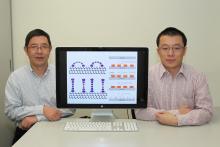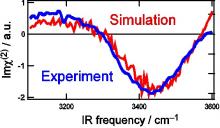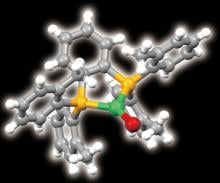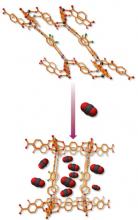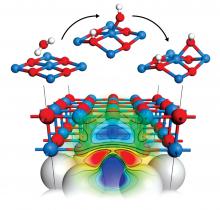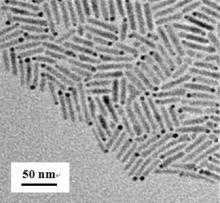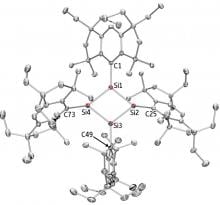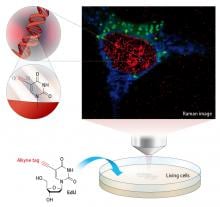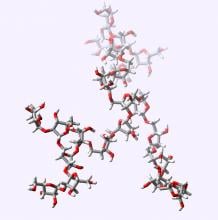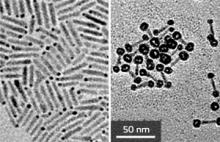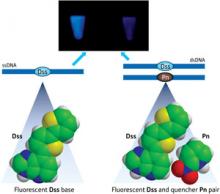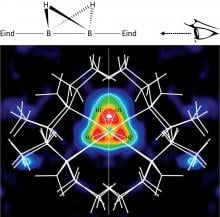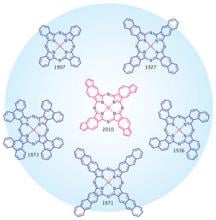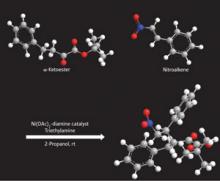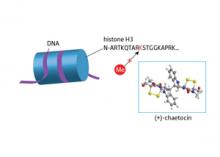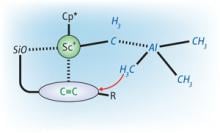Journal of the American Chemical Society (JACS)
News
04 Oct 2011
New study sheds light on the mysterious structure of the world’s most common liquid interface

19 Sep 2011
Molecule-based memory devices edge closer with the development of supramolecular structures that act as tiny magnets
19 Aug 2011
Electronic screens based on new energy-efficient technology could become more affordable thanks to the substitution of expensive metal components with copper ones

18 Aug 2011
A one-pot synthesis provides a simpler and faster route to highly efficient solar cells
12 Aug 2011
Materials made from porous coordination polymers with flexing structures make better traps for harmful gases

05 Aug 2011
High-speed laser measurements reveal new insights into rearrangements of light-driven chemical structures with implications for solar-energy conversion and opto-electric devices

01 Jul 2011
A newly discovered natural product produced by a fungus prevents cancer cells from becoming malignant
01 Jul 2011
Numerical simulations reveal that deliberately engineering defects into ultrathin oxide films enhances catalytic water-splitting reactions
13 Jun 2011
Researchers from Institute of Materials Research and Engineering have invented new ‘smart’ biomaterials including a unique hydrogel that has an on-off switch to precisely control its density and a new modular block copolymer that can be tailored to be triggered by specific temperatures.
07 Jun 2011
Scientists from Singapore have created a new chemical method that enables the development of a variety of tiny light conducting metal-semiconductor contacts. These light-sensitive nano-sized components could help create bioimaging labels as well as better photocatalysts used in fuel cells.
03 Jun 2011
Trapping four silicon atoms into a short-lived, diamond-shaped complex gives surprising insights into aromaticity
03 Jun 2011
The first cubic-shaped complexes of rare-earth metals and organic carbenes present chemists with a unique structure motif for carbene chemistry study
02 Jun 2011
National Institute of Materials Science announced that a chemical wiring method has been developed for interconnection of each organic molecule by electrically conductive polymers.
27 May 2011
Revealing the inner workings of cells takes a step forward using a newly developed Raman microscopy technique
06 May 2011
Novel tuberculosis treatments could result from success in artificially synthesizing sugar-based structures of the bacterium’s cell wall
03 May 2011
A novel photochemical process allows catalytic and magnetic metals to be deposited onto semiconductor nanorods without effort
25 Mar 2011
Solar-powered ‘nanoalloys’ can convert polluting nitrates into ammonia fertilizer without releasing carbon dioxide
04 Feb 2011
Twin zinc atoms can direct an important organic double-bond-forming reaction with greater efficiency than other methods
10 Dec 2010
Linking silicon and carbon double bonds into an extended network with bulky molecules produces air-stable and photo-responsive crystals
10 Dec 2010
The toolbox for imaging DNA now comes with an artificial DNA fluorescent base that can be ‘switched off’
19 Nov 2010
Bulky molecules help trap boron compounds into a never-before-seen structural arrangement
24 Sep 2010
Advanced laser spectroscopy exposes the unique organization of water molecules under model membrane surfaces
06 Aug 2010
Modifying a familiar class of dye molecules with optically active carbon rings creates new possibilities for light-based medical therapies

25 Jun 2010
Fluorescent unnatural base pairs light up the structures of DNA and RNA chains with minimal disturbance
04 Jun 2010
Finely tuned nickel complexes combine important biomolecular precursors with high efficiency and low environmental impact
07 May 2010
The first total synthesis of the complex natural product chaetocin expands the tools to reverse lethal gene expressions

19 Feb 2010
Size-controllable bulky ligands stabilize multiple bonds of heavy elements into photoactive materials
05 Feb 2010
A finely tuned rare-earth metal catalyzes the exact interactions needed for site-selective molecular synthesis

25 Sep 2009
Porous coordination polymers that strongly adsorb polar guest molecules can be made using a ligand with separated positive and negative charges
Events
Sorry, no events coming up for this topic.
Researchers
Sorry, no researchers coming up for this topic.
Giants in history
Sorry, no researchers coming up for this topic.


